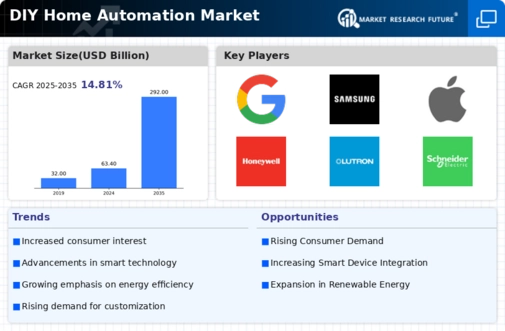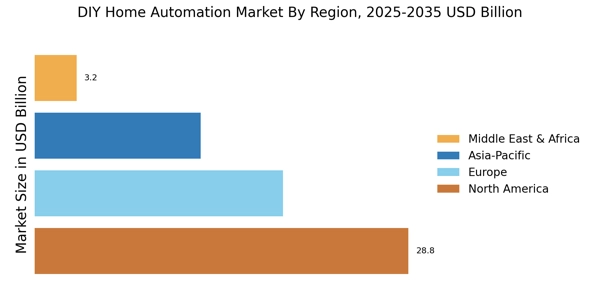Cost-Effectiveness of DIY Solutions
The DIY Home Automation Market benefits significantly from the cost-effectiveness of do-it-yourself solutions. As consumers become more budget-conscious, they are increasingly inclined to opt for DIY automation products that offer substantial savings compared to professionally installed systems. Market analysis reveals that the average cost of DIY home automation products is approximately 30 to 50% lower than traditional installation services. This affordability factor is likely to attract a broader audience, including those who may have previously considered home automation too expensive. Consequently, the DIY Home Automation Market is poised for growth as more consumers embrace these economical options.
Increased Awareness of Home Security
The heightened awareness of home security concerns is a significant driver for the DIY Home Automation Market. As crime rates fluctuate, homeowners are increasingly seeking ways to enhance their property security through automation. The availability of affordable DIY security systems, such as smart cameras and alarm systems, has made it feasible for consumers to take control of their home safety. Recent surveys indicate that nearly 60% of homeowners prioritize security features when considering home automation products. This growing emphasis on security is likely to fuel demand within the DIY Home Automation Market, as consumers look for effective and accessible solutions.
Sustainability and Energy Management
Sustainability concerns are becoming increasingly prominent, influencing the DIY Home Automation Market. Consumers are more aware of their environmental impact and are seeking solutions that promote energy efficiency. DIY home automation products that enable users to monitor and manage energy consumption are gaining traction. Data suggests that homes equipped with smart energy management systems can reduce energy usage by up to 30%. This potential for energy savings aligns with the growing trend towards sustainable living, making the DIY Home Automation Market an attractive option for environmentally conscious consumers.
Rising Consumer Interest in Smart Homes
The DIY Home Automation Market experiences a notable surge in consumer interest towards smart home technologies. This trend is driven by the increasing awareness of the benefits associated with home automation, such as enhanced security, convenience, and energy efficiency. According to recent data, approximately 70% of homeowners express a desire to integrate smart devices into their living spaces. This growing inclination towards smart homes is likely to propel the DIY Home Automation Market forward, as consumers seek affordable and user-friendly solutions that allow them to customize their home environments without professional assistance.
Advancements in Technology and Connectivity
Technological advancements play a pivotal role in shaping the DIY Home Automation Market. The proliferation of Internet of Things (IoT) devices has made it easier for consumers to connect and control various home systems remotely. With the introduction of more sophisticated and affordable smart devices, the market is witnessing a rapid expansion. Data indicates that the number of connected devices in households is expected to reach 50 billion by 2030, which suggests a robust growth trajectory for the DIY Home Automation Market. This technological evolution empowers consumers to create personalized automation systems tailored to their specific needs.

















Leave a Comment